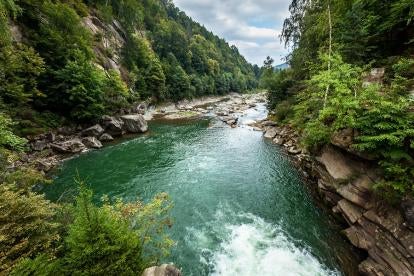On February 28, 2017, President Trump signed an Executive Order entitled “RESTORING THE RULE OF LAW, FEDERALISM, AND ECONOMIC GROWTH BY REVIEWING THE ‘WATERS OF THE UNITED STATES’ RULE.” The purpose of this briefing paper is to provide a summary of the background of the definition of “Waters of the United States” (“WOTUS”) and an analysis of the impact of the Executive Order.
The CWA can have significant impacts on industries, and thus expansions to its scope increase the burden felt by the regulated community. The Final Rule broadened the scope of the Clean Water Act (“CWA”) by expanding the definition of WOTUS. The Final Rule has been stayed in Federal Court and now has been targeted by the Executive Order. The current scope of the CWA (since the Final Rule is stayed) is ambiguous, as WOTUS are not well defined under Rapanos (as implemented by the Army Corps and EPA) particularly because the question of whether a water body is “jurisdictional” (other than a navigable or interstate water body, which is always jurisdictional), is subject to a case-by-case determination of the agencies and is not applied consistently across regions. The Final Rule was meant to provide certainty and clarification, and while it did that, it greatly increased the scope of the CWA and the burden on the regulated stakeholders. Consequently, a revised definition of WOTUS is needed, as is being directed by the Executive Order. But what remains to be seen is how the new Administration will replace the Final Rule with a WOTUS definition that provides clarity, certainty, and predictability to the regulated stakeholders.
I. Background leading up to the Final Rule
There have been several cases that have shaped the scope of the EPA and the Army Corps of Engineers jurisdiction over WOTUS under the CWA. Briefly, here are three seminal cases:
-
Riverside Bayview, 474 U.S. 121 (1985): Upheld the agencies’ authority to regulate wetlands adjacent to navigable waters.
-
SWANCC, 531 U.S. 159 (2001): Rejected the agencies’ authority to regulate isolated ponds based upon the potential presence of migratory birds (the Migratory Bird Rule).
-
Rapanos, 547 U.S. 715 (2006): The case raised the question as to what extent the CWA applies beyond traditional navigable and interstate waters. The Court voted 4-1-4, and the case was remanded for further proceedings.
-
Justice Stevens wrote a dissenting opinion (joined by Justices Souter, Bader Ginsburg, and Breyer) in which jurisdiction under the CWA was only limited, i.e., only did not extend, to truly isolated waters with no hydrological connection to traditionally navigable or interstate waters. He also noted that Justice Kennedy’s “Significant Nexus Test” would be controlling in most cases.
-
Justice Kennedy’s opinion effectively created the “Significant Nexus Test”: if the wetlands, either alone or in combination with similarly situated lands in the region, significantly affect the chemical, physical, and biological integrity of “traditional navigable waters,” then there is jurisdiction under the CWA.
-
Justice Scalia authored a plurality opinion (joined by Justices Roberts, Thomas, and Alito) in which jurisdiction under the CWA only extends to (1) “relatively permanent bodies of water” connected to traditional navigable waters; and (2) wetlands with a continuous surface connection to these waters, such that it is difficult to determine where the “water” ends and the “wetland” begins.
-
In 2008, to provide “clarification,” the EPA issued guidance stating its understanding of the significant nexus test to help “clarify” federal jurisdiction. The 2008 Guidance provided:
The Significant Nexus Test:
-
Assesses the flow characteristics and functions of the tributary itself and the functions performed by all wetlands adjacent to the tributary to determine if they significantly affect the chemical, physical and biological integrity of downstream traditional navigable waters.
-
Includes consideration of hydrologic and ecologic factors.
Thereafter, in 2011, the EPA proffered additional guidance regarding the agency’s interpretation and implementation of Rapanos, in which EPA applied the “significant nexus test” to “other waters,” and “similarly situated waters,” such that the CWA would apply to all waters of the same resource type with a hydrological connection which constituted a “significant nexus” to a traditional navigable or interstate water.
On May 27, 2015, the prepublication version of the Final Rule, “Clean Water Rule: Definition of ‘Waters of the United States,’” was released. The Final Rule has a 197-page preamble to explain the eight-page rule. The Final Rule increases the jurisdictional scope of the CWA by expanding the definition of “Waters of the United States” to make tributaries and adjacent waters, even those that are intermittent or ephemeral, “per se jurisdictional without the need for a significant nexus determination.” Preamble at p. 86.
II. Court Proceedings Related to the Final Rule
Before the Final Rule became effective, legal challenges to the rule were filed in multiple federal courts. These lawsuits were filed by industry groups, several environmental groups, and over half of the states; ultimately, totaling over 90 plaintiffs. On October 9, 2015, a three-judge panel of the Court of Appeals for the Sixth Circuit stayed the rule’s implementation nationwide. On February 22, 2016, the three-judge panel further concluded it had jurisdiction to hear the combined challenges to the Final Rule in the various federal courts. Various industry groups filed petitions for rehearing on this decision, all of which were denied on April 26, 2016. Following this decision, district courts across the country have dismissed individual challenges to the rule on jurisdictional grounds, stating that the Sixth Circuit is the appropriate venue. However, a district court in North Dakota declined to dismiss an action challenging the Final Rule, instead opting to put the action on hold pending the Sixth Circuit outcome. Similarly, the Eleventh Circuit put a hold on a similar challenge on August 16, 2016, stating it would wait until the Sixth Circuit action was resolved to proceed. On January 13, 2017, the Supreme Court granted a petition to hear an appeal to the Sixth Circuit’s ruling. On January 25, 2017, the Sixth Circuit granted a motion to hold its ongoing WOTUS litigation pending the Supreme Court’s decision.
Since the stay of the Final Rule litigation, the EPA and Army Corps of Engineers have continued to exercise their authority consistent with the “significant nexus test” as set forth in Rapanos and the definition of WOTUS effective prior to the Final Rule.
III. The Executive Order
On February 28, 2017, President Trump signed an Executive Order (“EO”) directing the Administrator of the EPA and the Assistant Secretary of the Army to review the Final Rule and publish for notice and comment a proposed rule rescinding or revising the same. The EO provides: “It is in the national interest to ensure that the Nation's navigable waters are kept free from pollution, while at the same time promoting economic growth, minimizing regulatory uncertainty, and showing due regard for the roles of the Congress and the States under the Constitution.”
The EO also directs all agencies involved with enforcing the Final Rule to rescind or revise enforcement related to the Final Rule; directs the heads of the EPA and Army Corps to notify the Attorney General in charge of the ongoing Final Rule litigation of the agencies’ pending review of the same; and orders that the EPA and Army Corp to consider interpreting the term “navigable waters” in a manner consistent with the opinion of Justice Antonin Scalia in Rapanos v. United States.
Effectively, this means the EO is requiring the EPA and Army Corps to consider interpreting the term “navigable waters” to mean those waters channels or bodies: (1) that were traditionally used for commerce or to transport people; (2) that are interstate; (3) that are “relatively permanent bodies of water” connected to traditional navigable waters; and (4) that are wetlands with a continuous surface connection to these waters, such that it is difficult to determine where the “water” ends and the “wetland” begins. Ultimately, the EO does not repeal the Final Rule, but instead directs the EPA and Army Corps to consider revising or repealing the same. Consequently, in the foreseeable future the Army Corps and EPA will continue to administer the CWA consistent with their interpretations of Rapanos prior to development of the Final Rule. In other words, the agencies will continue to have to make a case-by-case determination of applicability of the CWA to any waters other than navigable or interstate waters. Recall, the goal of the Final Rule was to reduce the need for a case-by-case determination for waters which, by rule, would be defined as jurisdictional under the CWA.
Any changes to the Final Rule will need to undergo proper administrative notice and comment periods, and it will take significant time before the Final Rule is ultimately revised or repealed. In the interim, the EO directs the EPA and Army Corps to notify the Attorney General of any pending review of the Final Rule “so that the Attorney General may, as he deems appropriate, inform any court of such review and take such measures as he deems appropriate concerning any such litigation pending the completion of further administrative proceedings related to the rule.” EO at Para. 2(c). Effectively, this will likely lead to the Attorney General requesting that the Supreme Court dismiss the ongoing WOTUS litigation as moot, or stay the action pending revision of the Final Rule.
From an industry perspective, the initial effect of the EO is as follows:
-
The Army Corps and EPA will apply the CWA such that “jurisdictional waters” are those which are navigable or interstate, or which have a “significant nexus” to navigable or interstate waters.
-
The “significant nexus test” will be applied on a case-by-case basis.
a) Persons and businesses which may impact wetlands or tributaries, whether permanent, intermittent, or ephemeral, have been thrust back into an environment of uncertainty and inconsistency, as the “significant nexus test” is applied differently from region-to-region.
b) Consequently, as was the case prior to the Final Rule, businesses should work with technical and legal experts to identify whether they will impact any WOTUS, ensuring that they develop materials which establish that any waters being impacted do not have a “significant nexus” to a navigable or interstate water body.
At some undefined point in the future, the EO will likely lead EPA and the Army Corps to adopt Justice Scalia’s narrower interpretation of WOTUS. However, it is important that any future rule provide clarity, as well as narrowing the scope of the definition of WOTUS. Ideally, to strike the balance of clarity and narrowing the definition of WOTUS a replacement rule will:
-
Clearly establish that ephemeral waters, i.e., those that only have water in response to precipitation, are presumed not to be WOTUS, and establish a high burden for the agencies to reach a conclusion to the contrary.
-
Clearly identify which waters are exempt from the CWA, taking into consideration the concerns of the regulated community.
-
Establish, to the greatest extent possible, a uniform approach for the agencies when determining whether a water body is “jurisdictional.” This is critical to avoid the current problem of inconsistency across regions, which prevents the regulated stakeholders from being able to effectively plan and ensure compliance with the CWA.
-
Establish streamlined processes for permitting, jurisdictional determination, and other CWA compliance obligations.
IV. Scope of the Final Rule
It is likely that environmental groups will fight to preserve the Final Rule, either in its current form or to ensure that its salient points are included in any replacement rule flowing from the EO. Consequently, it is important to understand the content of the Final Rule, as these concepts will no doubt resurface in the discussions and debates that follow the implementation of the EO.
Summarily, below are salient provisions of the Final Rule:
-
The provision discussing “Impoundments” is identical to the wording in the existing rule, but changed from the Proposed Rule to encompass not only impoundments of traditional navigable waters, interstate waters, or territorial seas, but also impoundments of tributaries and “adjacent” waters.
-
Under the Final Rule any waters meeting the definition of “tributary” or “adjacent” waters are jurisdictional if they are impounded and/or connected to a water body that is impounded and considered a traditional navigable water, interstate water, territorial sea, tributary, or adjacent water.
-
-
The Definition of “tributaries” represents one of the areas where EPA and Army Corps attempted to expand the scope of the CWA.
-
Under the Final Rule, a tributary is any water body, whether natural, man-altered, or manmade, which:
-
Has a bed and bank, and an ordinary high water mark, and
-
Contributes flow either directly, or indirectly, to a traditional navigable water, interstate water, territorial sea, or impoundment of the same.
-
-
“Waters through which a tributary may contribute flow indirectly include, for example, impoundments, wetlands, lakes, and other tributaries.” Preamble at p. 88.
-
The term “tributary” includes water bodies with perennial, intermittent, and ephemeral flows.
-
-
The new provision discussing “Adjacent” Waters, as defined in the Final Rule, represents one of the areas where EPA and Army Corps are expanding the scope of the CWA.
-
Adjacent waters are any waters, including wetlands, ponds, lakes, oxbows, impoundment, and similar waters, whether natural, man-altered, or manmade, which are bordering, contiguous, or neighboring a traditional navigable water, interstate water, territorial sea, tributary, or impoundment of the same.
-
Adjacent waters include water separated by constructed dikes or barriers, natural river berms, beach dunes, and the like.
-
Adjacent waters do not have to be located laterally to a traditional navigable water, interstate water, territorial sea, tributary, or impoundment of the same.
-
Adjacent water includes all waters which connect segments of a traditional navigable water, interstate water, territorial sea, tributary, or impoundment of the same.
-
-
There are categories of “other waters” subject to a case-specific determination as to whether they are jurisdictional, based upon the definition of “significant nexus.”
-
The specific categories are: (1) Prairie potholes; (2) Carolina bays and Delmarva bays; (3) Pocosins; (4) Western vernal pools; and (5) Texas coastal prairie wetlands.
-
The Final Rule also provides a categorical catch-all of “other waters” within a certain distance of traditional navigable water, interstate water, territorial sea, tributaries, or impoundments of the same, and that have a “significant nexus” to a traditional navigable water, interstate water, or territorial sea.
-
-
The definition of “significant nexus” in the Final Rule specifically enumerates factors, which independently or cumulatively, can establish a “significant nexus.”
-
“Significant Nexus” is defined to mean “a water, including wetlands, either alone or in combination with other similarly situated waters in the region, [which] significantly affects the chemical, physical, or biological integrity of [a traditional navigable water, interstate water, or territorial sea]. The term ‘in the region’ means the watershed that drains to the nearest [of a traditional navigable water, interstate water, or territorial sea]. For an effect to be significant, it must be more than speculative or insubstantial. Waters are similarly situated when they function alike and are sufficiently close to function together in affecting downstream waters.” The term “significant nexus” identifies the following aquatic functions as the basis for determining whether a “significant nexus” exists:
-
Sediment trapping;
-
Nutrient recycling;
-
Pollutant trapping, transformation, filtering, and transport;
-
Retention and attenuation of flood waters;
-
Runoff storage;
-
Contribution of flow;
-
Export of organic matter;
-
Export of food resources; and
-
Provision of life cycle dependent aquatic habitat for species located in a traditional navigable water, interstate water, or territorial sea.
-
-
-
The “Exceptions” were expanded to clarify which “ditches” are not jurisdictional and to clarify that existing exceptions stay the same with the addition of exceptions for erosional features, depressions in dry land associated with construction and mining which fill with water, and stormwater control features.




 i
i


